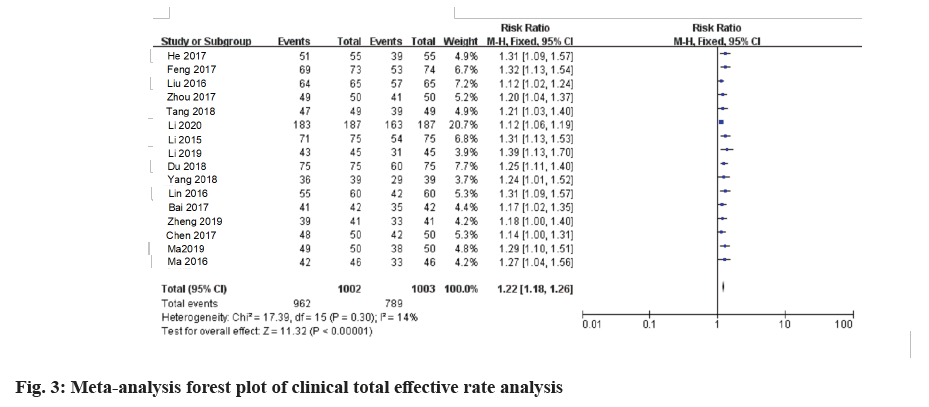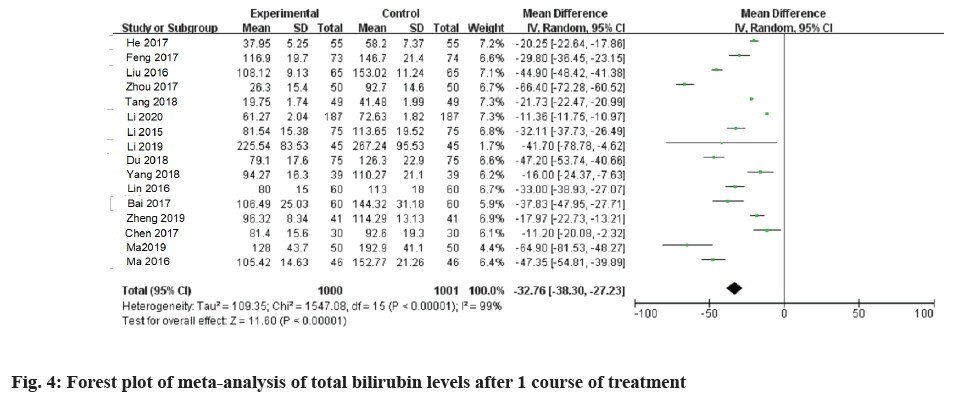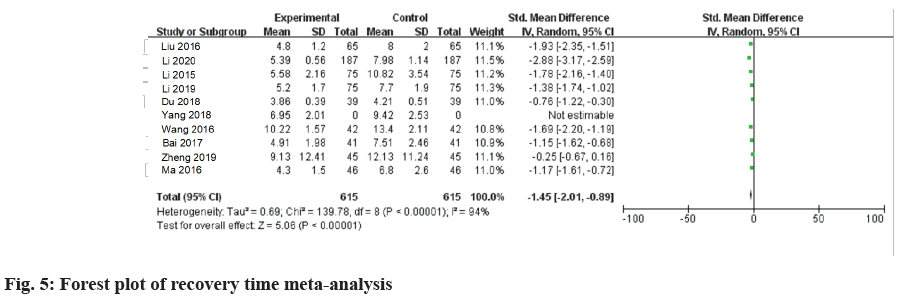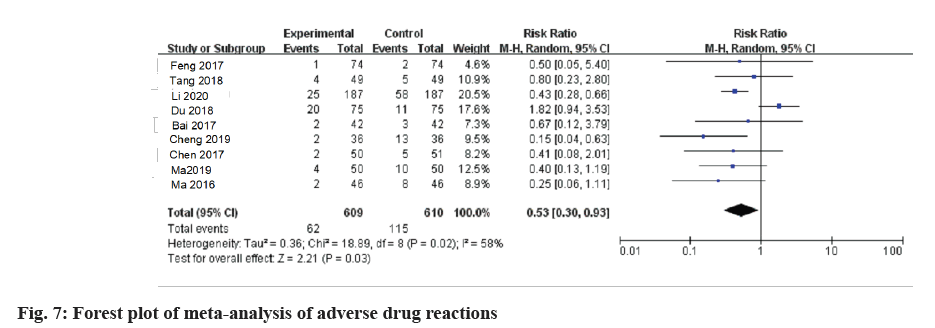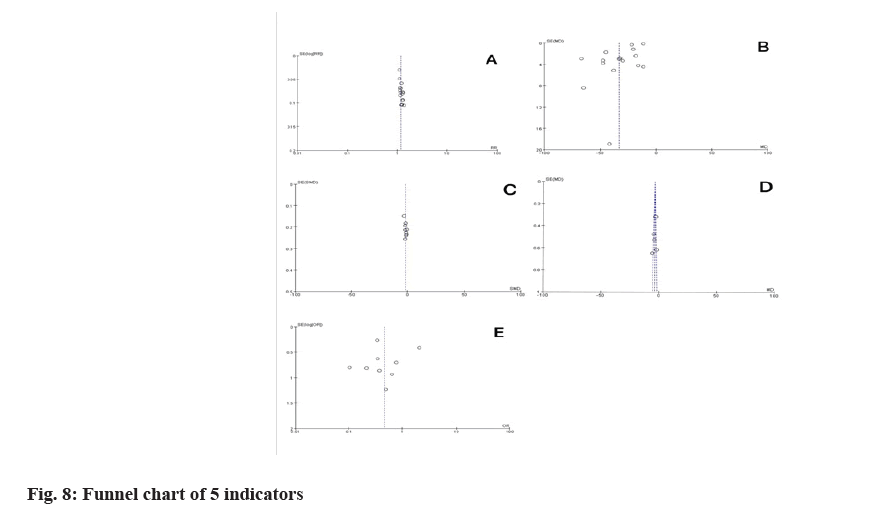- *Corresponding Author:
- L. Fan
Department of Pediatrics, Institute of Chinese Medical Literature and Culture, Jinan, Shandong 250355, China
E-mail: a13188908541@163.com
| This article was originally published in a special issue, “Current Trends in Pharmaceutical and Biomedical Sciences” |
| Indian J Pharm Sci 2022:84(5) Spl Issue “278-285” |
This is an open access article distributed under the terms of the Creative Commons Attribution-NonCommercial-ShareAlike 3.0 License, which allows others to remix, tweak, and build upon the work non-commercially, as long as the author is credited and the new creations are licensed under the identical terms
Abstract
To assess the efficacy and safety of Yinzhihuang granule combined with phototherapy in neonatal pathological jaundice treatment. By searching China network knowledge infrastructure, Wan Fang database, Virtual IP address database, Virtual IP, PubMed, EmBase together with the Cochrane library until March 31st, 2022. Literatures on Yinzhihuang combined with phototherapy in neonatal pathological jaundice treatment were collected. Literatures were screened by the inclusion and exclusion criteria and data were extracted. A total of 19 literatures were included in this study, a total of 2221 neonates with pathological jaundice. The outcomes of metaanalysis demonstrated the total clinical effective rate of Yinzhihuang combined with phototherapy in neonatal pathological jaundice treatment was significantly higher than that of phototherapy. At the end of one course of treatment, the total bilirubin level was significantly lower than that of the phototherapy group. The recovery time and hospital stay were shorter than those in the phototherapy group. The occurrence rate of adverse reactions was reduced compared to that of phototherapy group and the difference was significant. Yinzhihuang granule combined with phototherapy in neonatal pathological jaundice treatment has better clinical effect and safety.
Keywords
Yinzhhuang, pathological jaundice, phototherapy, curative effect, bilirubin
Neonatal jaundice refers to the aberrant metabolism of bilirubin and the clinical manifestations are yellow staining of skin, mucosa and even sclera caused by the elevated level of bilirubin in blood. It can be divided into pathological jaundice and physiological jaundice. It is one of the common pediatric diseases. In recent years, its incidence is increasing year by year[1]. Excessive bilirubin in the neonatal period can cause brain neuropathy (namely bilirubin encephalopathy), which is manifested as not eating, not drinking and not making any disturbance. It is the most serious complication of pathological jaundice in the newborn, with serious condition and high mortality and permanent nerve damage can be caused to the nerves[2]. The incidence of pathological jaundice in neonates is high in China. It is important to detect and effectively judge the nature of jaundice in time, diagnose and treat early, and prevent the occurrence of bilirubin encephalopathy. At present, the treatment of pathologic jaundice includes phototherapy, drug therapy and supportive therapy. Phototherapy is a common clinical treatment, including intermittent and continuous blue light irradiation. The treatment of drugs usually include probiotics (Mamaiai, Peifeikang, etc.), glucose powder, Yinzhihuang granule, which is the first choice for neonatal pathological jaundice treatment. Yinzhihuang granule is a preparation made of extracts of 4 kinds of traditional Chinese medicine, namely Artemisia, Gardenia, honeysuckle and Scutellaria. It has the effects of detoxification, dampness, heat clearing and allopathy. It is often used in the treatment of liver diseases in clinic and has been frequently used in neonatal pathological jaundice treatment in the last few years[3-5]. Yinzhihuang granule by regulating bilirubin metabolism reduces the absorption of bilirubin, reduce the occurrence rate of adverse drug reactions and shorten the treatment time. In recent years, a number of literatures have compared the efficacy and safety of Yinzhihuang combined with phototherapy and phototherapy in neonatal pathological jaundice therapy[6-24]. This study intended to collect domestic and foreign published studies on the efficacy and/or safety of Yinzhihuang combined with phototherapy and phototherapy in neonatal jaundice therapy and conducted a meta-analysis to assess the clinical efficacy and safety of Yinzhihuang combined phototherapy.
Materials and Methods
Inclusion criteria:
The clinical Randomized Controlled Trials (RCTs) of Yinzhihuang granule combined with phototherapy in neonatal pathological jaundice treatment were published at home and abroad. The study subjects met the diagnostic criteria of pathological jaundice in practical pediatrics at the age of 4 w after birth.
Intervention measures: The experimental group was treated with oral Yinzhihuang granules+phototherapy (blue light irradiation therapy), the control group was only treated with phototherapy, allowing patients to take symptomatic treatment when necessary (prevention of infection, relief of diarrhea, nutritional supplementation, etc.,).
Outcome index: The primary outcome index was clinical efficacy, which was determined according to the level of serum total bilirubin. Including four grades cure, special effect, effective and ineffective. Secondary outcome measures included direct bilirubin, indirect bilirubin, recovery time (defined as the time from onset to resolution of jaundice) and adverse drug reactions. Among them, the clinical effect was determined according to the clinical efficacy judgment standard of neonatal pathological jaundice in pediatrics.
The total effective rate=Significant efficiency+effective rate
Exclusion criteria:
The subjects had physiologic jaundice, hepatobiliary diseases or other hereditary diseases; non-randomized, non-clinical studies, retrospective studies, repeated literature, conference abstracts, reviews, individual cases, review literature; poorly designed studies with no outcome measures, incomplete and/or extractable outcome data, no control group, non-Chinese and English literature.
Search strategy:
China Network Knowledge Infrastructure (CNKI), Wan fang Data, Virtual IP Address, PubMed, Embase and Cochrane Library databases were searched to collect RCTs of Yinzhihuang granule combined with phototherapy in neonatal pathological jaundice therapy. The search time limit was from March 31st, 2022. The search method of combining subject words and free words was used. The search words were Yinzhihuang granule, jaundice and the English search words were Yinzhihuang, jaundice and so on.
Literature selection and data extraction:
Two researchers screened the literature based on the inclusion and exclusion criteria, extracted data, discussed and decided by a third party in case of disagreement. End note X7 was used for literature screening to eliminate duplicate documents and irrelevant literature was excluded by reading the title and abstract. Finally, the full text was read to determine the included literature based on the inclusion criteria and exclusion criteria. The included literature was read through and extracted; title, author name, published literature, sample size and baseline data (age, gender, etc.,) of the experimental group and the control group, study type and intervention measures and outcome indicators.
Literature quality evaluation:
By Cochrane RevMan5.3 software risk bias tool for quality evaluation into the literature including seven items. The generation of random sequence and allocation concealment (perpetrators and participants), double blind and ending index evaluation personnel blinded, incomplete data, publication bias, other bias, each project bias risk include: low risk, uncertain and high risk.
Statistical analysis:
RevMan5.3 software was used for meta-analysis. Relative Risk (RR) was used for enumeration data and Standard Mean Difference (SMD) was used for measurement data. When I2≤50 %, p>0.05, the possibility of heterogeneity was small and the fixed effect model was used. When I2>50 % and p≤0.05, heterogeneity was indicated and subgroup analysis or random effect model analysis was used. The pooled statistic was p<0.05 to indicate statistical significance.
Results and Discussion
As displayed in fig. 1, a total of 886 articles were included in the primary selection, containing 189 articles from CNKI, 404 articles from Wan fang, 216 articles from VIP, 7 articles from PubMed, 2 articles from Embase and 68 articles from Cochrane Library. Based on the inclusion criteria, the most popular 19 articles were included in the meta-analysis via reading the title, abstract and full text. The basic information of the included literature was indicated in Table 1.
| Included studies | Sample size (male/female) | Average age (day) | Intervening measure | Yin Zhihuang dose | Course of treatment (Day) | Outcome indicator | |||
|---|---|---|---|---|---|---|---|---|---|
| T | C | T | C | T | C | ||||
| Fengmin et al.[6] | 23/16 | 21/18 | 10.43±3.86 | 10.15±3.69 | Yinzhihuang granules+intermittent blue light irradiation+live binary Bacillus subtilis | Intermittent blue light irradiation+live binary Bacillus subtilis | 3 g/d | 5 |
|
| Li et al.[7] | 46/29 | 48/27 | 5.32±1.35 | 5.28±1.34 | Yinzhihuang granule+intermittent blue light irradiation | Intermittent blue light irradiation | 3 g/d | 7 |
|
| Hongguang et al.[8] | 24/18 | 23/19 | 10.69±1.63 | 10.74±1.85 | Yinzhihuang granule+blue light irradiation+Saccharomyces boulardii sachets | Blue light irradiation+Saccharomyces boulardii sachets | 3 g/d | 5 |
|
| Li et al.[9] | 29/16 | 28/17 | 15.21±2.11 | 15.28±2.12 | Yinzhihuang granule+single blue light irradiation | Single blue light irradiation | 7.5 ml/d | 7 |
|
| Chen et al. [10] | 16/14 | 17/13 | 8.1±1.6 | 7.5±13 | Yinzhihuang granule+blue light irradiation | Blue light irradiation | NA | 7 |
|
| Zhou et al.[11] | NA | NA | NA | NA | Yinzhihuang granule+blue light irradiation | Blue light irradiation | 3 g/d | 6 |
|
| Bai et al.[12] | 23/19 | 25/17 | 8.1±3.2 | 8.5±3.4 | Yinzhihuang granule+blue light irradiation | Blue light irradiation | 3 g/d | 5 |
|
| Xiufang et al.[13] | 48/25 | 47/27 | 5.31±1.02 | 5.11±1.03 | Yinzhihuang granule+intermittent blue light irradiation | Intermittent blue light irradiation | 3 g/d | 7 |
|
| Juan et al. [14] | 40/35 | 39/36 | NA | NA | Yinzhihuang granule+blue light irradiation | Blue light irradiation | 3 g/d | 5 |
|
| Deyong et al.[15] | 19/17 | 17/19 | NA | NA | Yinzhihuang granule+blue light irradiation | Blue light irradiation | 4.5 g/d | 7 |
|
| Ying et al.[16] | 31/24 | 32/23 | 7.11±1.16 | 7.01±1.12 | Yinzhihuang granule+blue light irradiation | Blue light irradiation | NA | 6 |
|
| Fang et al.[17] | 32/28 | 32/28 | 5. 4±0. 9 | 6. 2±0. 7 | Yinzhihuang granule+blue light irradiation | Blue light irradiation | 3 g/d | 7 |
|
| Yan et al.[18] | 26/24 | 27/23 | 17.25±2.03 | 17.30±0.08 | Yinzhihuang granule+blue light irradiation | Blue light irradiation | 3 g/d | 7 |
|
| Huanan et al.[19] | 28/13 | 23/18 | 15.13±6.87 | 15.41±6.91 | Yinzhihuang granule+intermittent blue light irradiation | Intermittent blue light irradiation | 3 g/d | 7 |
|
| Xiaoli et al.[20] | 31/15 | 29/17 | 7.0±2.3 | 7.2±2.5 | Yinzhihuang granule+blue light irradiation | Blue light irradiation | 3 g/d | 7 |
|
| Li et al.[21] | 101/86 | 116/71 | 4.30±1.46 | 4.22±1.49 | Yinzhihuang granule+pure blue light irradiation | Pure blue light irradiation | 3 g/d | 7 |
|
| Shan et al.[22] | 37/28 | 38/27 | 14.2±2.0 | 14.2±1.9 | Yinzhihuang granule+pure blue light irradiation | Pure blue light irradiation | 3 g/d | 7 |
|
| Qibing et al.[23] | 26/24 | 27/23 | 14.2±2.9 | 13.9±2.8 | Yinzhihuang granule+pure blue light irradiation | Pure blue light irradiation | 3 g/d | 7 |
|
| Jingli et al.[24] | 29/20 | 31/18 | 10.63±5.17 | 10.85±5.31 | Yinzhihuang granule+pure blue light irradiation | Pure blue light irradiation | 3 g/d | 7 |
|
Note: (1): Clinical efficacy; (2): Bilirubin; (3): Total bile acids; (4): Recovery time; (5): Length of hospital stay; (6): Company with other and (7): Adverse reactions
Table 1: Basic Information of The Included Literature
The 19 included literatures all mentioned the specific method of randomization, complete outcome data and no selective reporting. No literatures mentioned the allocation hiding and whether it was double-blind (implementer and participant). The 3 literatures did not mention whether the outcome indicator evaluation was blinded, as shown in fig. 2.
A total of 16 studies were included, and the heterogeneity test showed that there was no significant heterogeneity among the studies (χ2=17.39, p=0.30, I2=14 %). The fixed-effect model was utilized for analysis and the results were shown in fig. 3. The results unveiled a significant difference in the total effective rate between the two groups (RR=1.22, 95 % CI=(1.18,1.26), p<0.00001). The total effective rate of Yinzhihuang granule combined with phototherapy in neonatal pathological jaundice therapy was significantly higher than that of phototherapy.
A total of 16 studies were included and the heterogeneity test manifested a significant heterogeneity among the studies (χ2=109.35, p<0.00001, I2=99 %). The random effect model was adopted to analyze the results, as indicated in fig. 4. The results demonstrated that the difference of serum total bilirubin level between the two groups was significant (SMD=-32.76, 95 % CI=(-38.30, -27.23), p<0.00001). The serum total bilirubin level of Yinzhihuang granule combined with phototherapy in neonatal pathological jaundice treatment was lower than that of phototherapy.
A total of 10 studies were included and the heterogeneity test showed a significant heterogeneity among the studies (χ2=139.78, p<0.00001, I2=94 %). The random effects model was utilized to analyze the results, as shown in fig. 5. The results displayed that the difference of recovery time between the two groups was significant (SMD=-1.45, 95 % CI=(-2.01, -0.89), p<0.00001). Yinzhihuang granule combined with phototherapy in the treatment of neonatal pathological jaundice had a shorter recovery time than phototherapy. A total of 5 studies were included and the heterogeneity test showed that there was significant heterogeneity among the studies (χ2=25.54, p<0.0001, I2=84 %). The random effect model was used for analysis and the results were shown in fig. 6. The analysis results showed that the difference of hospital stay between the two groups was statistically significant (SMD=-3.55, 95 % CI=(-4.65,- 2.46), p<0.00001). Yinzhihuang granule combined with phototherapy in neonatal pathological jaundice treatment had a shorter hospital stay than phototherapy.
A total of 9 studies were included and the heterogeneity test exhibited a significant heterogeneity among the studies (χ2=18.89, p=0.02, I2=58 %). The random effect model was adopted to analyze the results, as shown in fig. 7. The outcomes uncovered a significant difference in the occurrence rate of adverse reactions between the two groups (RR=0.53, 95 % CI=(0.30, 0.93), p=0.03). The occurrence rate of adverse reactions of Yinzhihuang granule combined with phototherapy in neonatal pathological jaundice treatment was lower than that of phototherapy.
The funnel plot was drawn with the five outcome indicators of total clinical response rate, total serum bilirubin, recovery time, length of hospital stay, as well as adverse drug reactions, as shown in fig. 8. The results showed that the included literatures of total clinical response rate, recovery time and length of hospital stay were basically symmetrically distributed in the funnel plot, and the possibility of publication bias was small. The three items of serum total bilirubin and adverse drug reactions were not symmetrically distributed in the funnel plot, suggesting that there may be a large publication bias.
According to traditional Chinese medicine, the pathogenesis of pathological jaundice is cold and dampness block, dampness and heat stasis, and bile overflow, which is related to cold and dampness, and dampness and heat[25]. Yinzhihuang granule comes from Yinchen Hao soup, 4 kinds of drugs synergistic effect, can get the effect of clearing heat and detoxifying, removing yellow and dampening, protecting liver and gallbladder. Yinzhihuang is used in the treatment of neonatal pathologic jaundice, but the sample size of the literature published in recent years is small. This study finally included 19 articles for research through screening, and the results showed that the treatment of Yinzhihuang combined with phototherapy in neonatal pathologic jaundice could effectively improve the clinical total effective rate, reduce serum total bilirubin level, shorten the recovery time and hospital stay. At the same time, the occurrence rate of adverse reactions was reduced and the safety was good.
Yinzhihuang granule has the function of protecting liver and gallbladder, by regulating Alanine Aminotransferase (ALT), total bile acid and other indicators, to achieve the role of regulating liver function. With the excretion of bilirubin in urine and feces, the jaundice is gradually subsided and the skin symptoms are improved. Some studies have shown that the main effects of Yinzhihuang granule can reduce bilirubin level[26]. Compared with injection, oral administration not only avoids allergy, but also avoids invasive operation. Besides, its antibacterial effect is improved and the destruction of red blood cells is reduced when combined with antibiotics. Moreover, it can inhibit body allergy, reduce red blood cell hemolysis. Experimental studies in rats with hyperbilirubinemia have showed that Yinzhihuang granules inhibit the increase of bilirubin by elevating the expression of organic anion transport polypeptide 1b2, multidrug resistance associated protein 2 and Uridine Diphosphate (UDP)-glucuronosyltransferase 1A1[27]. Some studies have shown that Yinzhihuang granule can promote the secretion and antagonism of bile, improve the levels of serum liver enzymes and accelerate the jaundice resolution time[28]. It can effectively reduce the level of bilirubin, improve the clinical efficiency, as well as shorten the recovery time and hospital stay. Yinzhihuang combined with phototherapy in neonatal pathological jaundice treatment has a significant clinical effect. In terms of safety, combination therapy has a lower occurrence rate of adverse reactions. The side effects of phototherapy include fever, diarrhea, skin rash erythema, testicular damage and dehydration, etc.,[29] while the side effects of Yinzhihuang are often manifested as diarrhea and vomiting, especially in patients with spleen deficiency and loose stool[30]. The above side effects are mild and can be relieved spontaneously after discontinuation of the drug. However, but the results of this study results indicated that Yinzhihuang combined with phototherapy treatment had lower occurrence rate of adverse reactions and better security[1-19]. In this study, all the included literatures adopted clear randomization method and reported complete data without high risk bias. However, the literature included in this study did not mention whether it was double-blind or allocation hiding.
In conclusion, 19 literatures were included in this study to analyze the clinical effect and safety of Yinzhihuang combined phototherapy in the treatment of neonatal pathological jaundice. The results showed that Yinzhihuang combined phototherapy was better than phototherapy in the treatment of neonatal pathological jaundice and the safety was also better than phototherapy. However, there are some limitations in these studies, such as no blinded method, no further follow-up of children, single case source and no multicenter study, etc. The clinical effect and safety of Yinzhihuang combined phototherapy in neonatal pathological jaundice treatment need to be confirmed by clinical multicenter prospective studies.
Conflict of interests:
The authors declared no conflict of interests.
References
- Weixiu Y, Xuemei R, Bangsong J. Effects of infantile massage combined with Yinchenhao decoction combined with short-term and multiple blue light irradiation on liver function, myocardial enzyme spectrum and nerve function in neonatal jaundice children. Dietary Health 2021;33:88-89.
- Haina D, Yan C, Caijun Y. Effect of traditional Chinese medicine bath combined with blue light irradiation on neonatal jaundice. Chin Sci Technol Tradit Chin Med 2020;27(6):144-6.
- Fang Z, Jiyuan C, Yu Z. Effect of Yinzhihuang oral liquid and mia combined with phototherapy on neonatal jaundice. Pharm Industry 2019;4:1.
- Huifang S, Yanlin L, Wei D. Comparison of two different feeding methods of Yinzhihuang oral liquid in the treatment of neonatal jaundice. Chin J Clin Pharmacol 2022;3:101-3.
- Caidie T, Jian L, Yanming X. Systematic review and meta-analysis of Yinzhihuang oral liquid in the treatment of neonatal jaundice. Chin J Tradit Chin Med 2019;24:10.
- Fengmin Y. Clinical study of live Bacillus subtilis combined with Yinzhihuang granule in the treatment of neonatal hyperbilirubinemia. Mod Diag Ther 2018;24:2.
- Li J, Hu Y. Clinical study of blue light combined with Yinzhihuang granule in the treatment of neonatal pathological jaundice. Chin J Clin Pharmacol 2015;18:1809-11.
- Hongguang W. Blue light irradiation combined with Yinzhihuang granule and Saccharomyces boulardii powder in the treatment of neonatal jaundice efficacy observation. J Pregnancy 2020;2(5):76-7.
- Li L. Effect of Yinzhihuang granule combined with blue light in the treatment of neonatal jaundice. Chin Med Guide 2019;17(18):2.
- Chen J, Yuan H, Chen Z. Efficacy evaluation of Yinzhihuang granules in adjuvant treatment of neonatal jaundice. Shenzhen J Integr Tradit Chin West Med 2017;27(10):32-3.
- Zhou J. Clinical effect of Yinzhihuang granule combined with blue light irradiation on neonatal jaundice. World Clin Med 2017;11(4):1.
- Bai C. Clinical analysis of Yinzhihuang granule combined with blue light in the treatment of 42 cases of neonatal jaundice. Health J 2017;12:137.
- Xiufang F. Effect of Yinzhihuang granule combined with blue light on thyroid function, AFP and CRP in neonates with pathological jaundice. Chin Mat Child Health 2017;19.
- Juan D, Xiaoqin Z. Yinzhihuang granule in the treatment of neonatal pathological jaundice. Jilin Tradit Chin Med 2018;38(9):1046-9.
- Deyong C, Xiaoling D, Hao C. Clinical effect of Yinzhihuang granule in the treatment of neonatal jaundice. Chin J Biochem Drugs 2017;37(6):3.
- Ying H, Manhong C. Effects of Yinzhihuang granule combined with short-term multiple blue light irradiation on serum TBIL, ALT, AST in children with jaundice. Chin J Biochem Drugs 2017;37(12):2.
- Fang L, Jie S. Comparison of curative effect between blue light therapy and compound Chinese medicine in the treatment of neonatal jaundice. Med Rev 2016;22(12):3.
- Yan M, Lan G, Li G. Efficacy and safety analysis of blue light irradiation combined with Yinzhihuang granule in the treatment of neonatal jaundice. World Tradit Chin Med 2019;14(12):4.
- Huanan Z. Clinical study on Yinzhihuang granule combined with blue light intermittent irradiation in the treatment of neonatal pathological jaundice. New Chin Med 2019;8:3.
- Xiaoli M, Lianying L. Clinical study on Yinzhihuang granule combined with blue light irradiation in the treatment of damp-heat fumigated neonatal jaundice. Liaoning J Tradit Chin Med 2016;43(2):3.
- Li ZH, Xie CC, Tao DY. Clinical observation of Yinzhihuang granule in the treatment of neonatal pathological jaundice. Chin Prac Med 2020;15:14-6.
- Shan L. Clinical efficacy of Yinzhihuang granule in the treatment of neonatal pathological jaundice. J Rational Clin Drug Use 2016;9(3):137-8.
- Qibing C, Jiandong C. Clinical efficacy and safety of Yinzhihuang granule in the treatment of neonatal pathological jaundice. J Rational Clin Drug Use 2017;10(23):2.
- Jingli T, Xiaoping L, Shouqiong Z. Effect of Yinzhihuang combined with blue light irradiation on neonatal jaundice. Hainan Med J 2018;29(3):3.
- Aizhen W, Lijuan G, Huiling J. Effect of traditional Chinese medicine treatment and nursing measures on wet heat fumigated neonatal pathological jaundice. New Chin Med 2020;52(7):4.
- Cai H. Effect analysis of Yinzhihuang oral liquid in treatment of cholestatic jaundice. J Clin Med 2020;7(96):1.
- Jianlong L. Clinical study of Yinzhihuang Granule in the treatment of neonatal pathological jaundice. Shanxi Univ Tradit Chin Med 2015.
- Juanlei L, Songyan Y, Yaning Q. Effect of blue light irradiation combined with Yinzhihuang in the treatment of neonates with pathologic jaundice and its influence on bilirubin and total bile acids. Family Med 2020;2:50-4.
- Hongli C, Ting W. Clinical effect of Yinzhihuang oral liquid combined with blue light on neonatal hyperbilirubinemia. J Clin Med Res Pract 2020;5(7):3.
- Xiao F, Xiaomei D. Research progress on adverse effects of phototherapy in neonates with hyperbilirubinemia. J Clin Pediatr 2020;38(9):5.
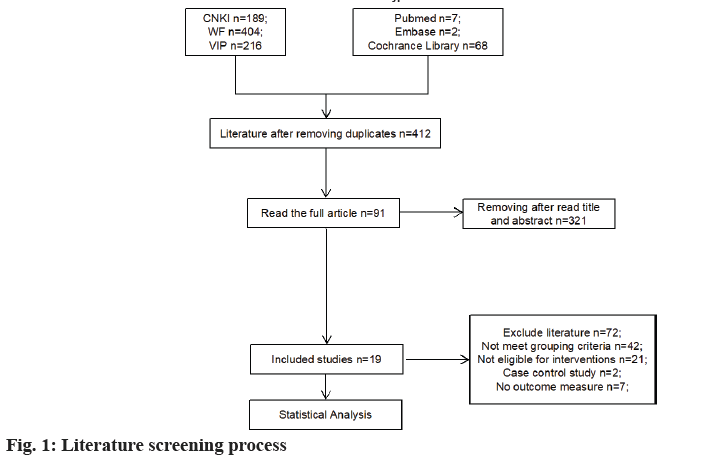
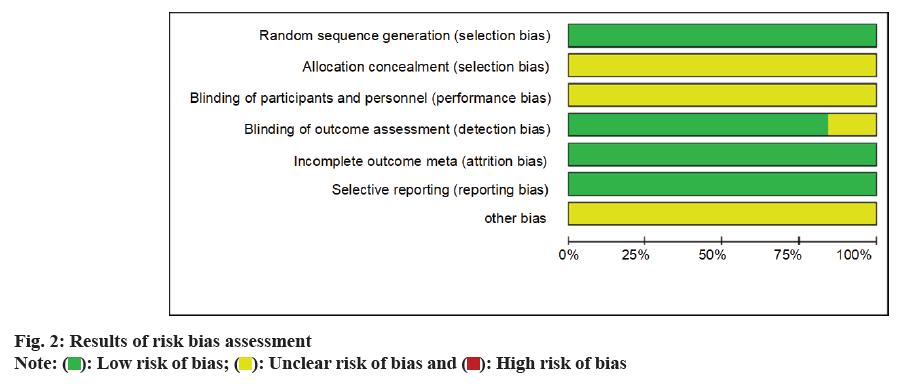
 ): Low risk of bias; (
): Low risk of bias; ( ): Unclear risk of bias and (
): Unclear risk of bias and ( ): High risk of bias
): High risk of bias